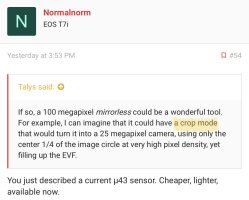No, sorry, I must be unclear.
Currently, the most reach (pixels of a small distant object) you can get without getting super exotic lenses is 50 megapixel on 600mm at f4, plus extenders. With APSC or MFT, you dont get more density than a 5DSR, so you dont get more reach. You also need to let in enough light for snappy autofocus, so it is not ok to not just put extenders on extenders and end up with an f/11 or worse lens.
100 megapixels would clearly increase that reach (again, more pixels of the faraway small object) . There will probably never be a MFT or APSC sensor with the same pixel density as a 100 megapixel AND supertelephotos with as much focal length as what will be available for a 100 megapixel full frame.
Mirrorless would be nice because that crop mode in EVF makes composition and manual focus much easier than taking the shot and then checking it after.
The closest thing to this that works like what I describe today is the a7R3, but not many people would be happy with paired EF super telephotos (slow AF, unusable with TCs), plus 43 megixels really isn't much different from 30 when it comes to cropping (surprisingly)
Correct except you said "a crop of a 100MP sensor" Thus that is the same (close enough) pixel density as a µ43. As for enough light for decent AF, as mirrorless cameras focus using the sensor, the photons per square mm are the same as FF aperture for aperture. Thus Oly's 300mm f4 is delivering as many photons to a pixel as the FF 600 f4.
The OVF in my 5DsR and mkIV both show the crops in the VF and later on the LCD.
Upvote
0

